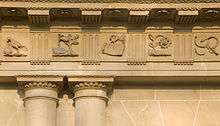Circus (Bath)
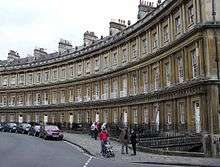 A view of The Circus | |
| Former name(s) | King's Circus |
|---|---|
| Length | 700 ft (200 m) |
| Postal code | BA1 2 |
| Coordinates | 51°23′10″N 2°21′50″W / 51.386°N 2.364°WCoordinates: 51°23′10″N 2°21′50″W / 51.386°N 2.364°W |
| Construction | |
| Construction start | 1754 |
| Completion | 1768 |
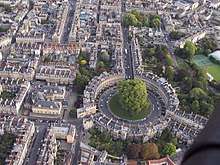
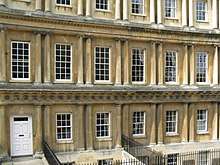
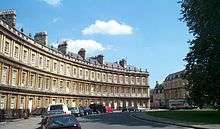
The Circus is a historic street of large townhouses in the city of Bath, Somerset, England, forming a circle with three entrances. Designed by the prominent architect John Wood, the Elder, it was begun in 1754, completed in 1768, and is regarded as a preeminent example of Georgian architecture. The name comes from the Latin 'circus', which means a ring, oval or circle. It has been designated as a Grade I listed building.[1]
The Circus is divided into three segments of equal length, with a lawn in the centre. Each segment faces one of the three entrances, ensuring a classical facade is always presented straight ahead.
History
The Circus, originally called King's Circus, was designed by the architect John Wood, the Elder. Convinced that Bath had been the principal centre of Druid activity in Britain,[2] Wood surveyed Stonehenge, which has a diameter of 325 feet (99 m) at the outer earth bank, and designed the Circus with a 318 feet (97 m) diameter to mimic this.[3][4]
Wood died less than three months after the first stone was laid; his son, John Wood, the Younger, completed the project to his father's design. The initial leases for the south west segment were granted in 1755–1767, for the south east segment in 1762–1766, and for the north segment in 1764–1766.
The Circus was part of John Wood the Elder's grand vision to recreate a classical Palladian architectural landscape for the city. Other projects included nearby Queen Square and the never-built Forum. The culmination of Wood's career, the Circus is considered his masterpiece.[5]
Painter Thomas Gainsborough lived in Number 17 between 1758 and 1774, using part of its space as his portrait studio.[6]
Number 15 The Circus was home to Admiral Sir Richard Bickerton and his family in the first half of the 19th century.[7]
During the Bath Blitz of 25/26 April 1942, one of the Baedeker Blitz retaliatory raids on England following the RAF's raid on Lübeck, a bomb fell into the Circus, demolishing several of the houses. These have since been reconstructed in the original style.
Architectural historian Dan Cruickshank selected the Circus as one of his five choices for the 2006 BBC television documentary series Britain's Best Buildings.[8]
Design
Three Classical orders (Greek Doric, Roman/Composite and Corinthian) are used, one above the other, in the elegant curved facades. The frieze of the Doric entablature is decorated with alternating triglyphs and 525 pictorial emblems, including serpents, nautical symbols, devices representing the arts and sciences, and masonic symbols. The parapet is adorned with stone acorn finials.
When viewed from the air, the Circus, along with Queens Square and the adjoining Gay Street, form a key shape, which is a masonic symbol similar to those that adorn many of Wood's buildings.[9]
The central area was paved with stone setts, covering a reservoir in the centre that supplied water to the houses. In 1800 the Circus residents enclosed the central part of the open space as a garden. Now, the central area is grassed over and is home to a group of old plane trees.
References
- ↑ "The Circus". Images of England. Historic England. Retrieved 2009-07-19.
- ↑ Elliot, Kirsten (2004). The Myth-Maker: John Wood 1704–1754. Akeman. pp. 24–25. ISBN 978-0954613822.
- ↑ Conway, Hazel; Roenisch, Rowan (2006). Understanding Architecture: An Introduction to Architecture and Architectural History. p. 35.
- ↑ Elliot, Kirsten (2004). The Myth-Maker: John Wood 1704–1754. Akeman. p. 64. ISBN 978-0954613822.
- ↑ Gadd, David, Georgian Summer, Countryside Books, updated edition 1987.
- ↑ Greenwood, Charles (1977). Famous houses of the West Country. Bath: Kingsmead Press. pp. 74–76. ISBN 978-0-901571-87-8.
- ↑ "Dame Anne Hussey Bickerton, 15 Circus, Bath, widow of Sir Richard Hussey Bickerton late of Upwood, Hampshire, bt". National Archives. Retrieved 5 August 2017.
- ↑ Cruickshank, Dan. "Britain's Best Buildings". BBC Four. Retrieved June 3, 2008.
- ↑ Thomas, Ceri. "The Royal Crescent in Bath". Pictures of England. Retrieved 10 June 2012.
Bibliography
- Michael Forsyth, Bath, Pevsner Architectural Guides, Yale University Press, 2003.
- Jean Manco, The Hub of the Circus: A history of the streetscape of the Circus, Bath (Bath and North East Somerset Council 2004).
External links

- Bath Past: The Circus — an article by Jean Manco.
